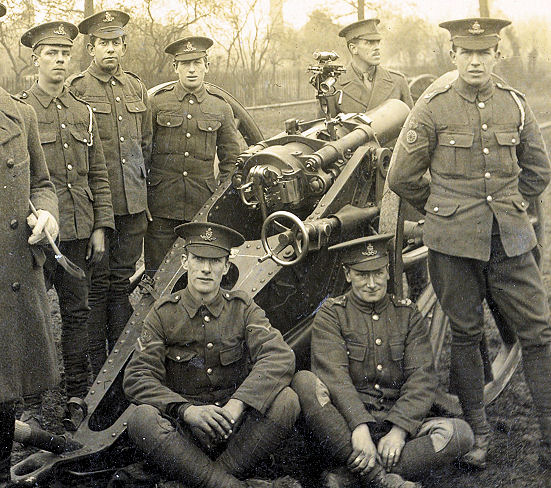|
8th London (Howitzer) Brigade Royal Field Artillery |
|
|||||||
|
8th London (Howitzer) Brigade Royal Field Artillery |
|
|||||||
When the First World War started the 2nd London Division moved to Hertfordshire, centred on St Albans, while the 5th-8th Brigades of the Royal Field Artillery went to Hemel Hempstead, with the 8th Brigade being based in Apsley.
|
This picture has been confirmed to be the 8th London (Howitzer) Brigade who were based in Apsley by Fiona Jenkins who writes
The officer at the rear of the attached photo, looking away from the camera is Eustace Nugent Fitz-George de Radcliffe Cooper. I know, from the London Gazette, that Eustace was part of the 8th London Howitzer Brigade He was born 23 June 1881, Dover, Kent. He joined the Army 4 Oct 1895. He was bought out of the Army in 1904, and then re-joined as an officer in 1912, resigned in 1913, re-joined in 1914 and resigned for the final time in 1921. After being in the 8th London Howitzer Brigade, he was in the Transport Workers Battalions, Bedfordshire Rifles, and then Transport Workers Battalions. Scotish. Rifles, 20th Battalion. It then looks as if he was with the Territorial Force Reserve, 8th London Beigade, which I assume is different from the 8th Lon Howitzer Brigade...
Photograph by L. L. Christmas, 23 Catherine Street, St Albans. |
||
 |
|
8th London (Howitzer) Brigade R.F.A. (later the 238th Brigade R.F.A.) The commander was Lieutenant Colonel Edward Henry Eley, who was awarded a D.S.O. in 1918 and subsequently became A.D.C. to the King between 1927 and 1941. The Orderly Officer was Lieutenant E. N. Fitz-G de R. Cooper and the adjutant was Major G. L. Popham. The chaplain was the Rev. Derman Christopherson, [brother of Percy Christopherson of Lockers Park School]. The 21st County of London Battery was commanded by Major Ernest Eton, while Captain Arthur John Cowan later commanded the D/235th Battery under Lieutenant Colonel Gordon. The 22nd County of London Battery was commanded by Major Cyril Arthur Pollard, assisted by Captain F. B. Osborne. The 8th London Brigade Ammunition Column was commanded by Captain W. G. Largen when it came to Hemel Hempstead, but he was succeeded by Captain E. C. White in December, 1914. |
When the troops first arrived in Hemel Hempstead it was August and they commandeered any available empty buildings - which included the schools. The 8th Brigade were based in Apsley, with the 21st Battery at Shendish. On the final Sunday in August The troops billeted at Shendish and in the Apsley district attended the morning service at Apsley Church on Sunday, the preacher being the Rev. J H R Lendrum. The National Anthem was heartily sung at the close of the service by the choir and congregation. At about the same time the YMCA opened a tent for the 8th Brigade in Salmon Meadows, Apsley, but once the autumn gales started moved into the local Church rooms.
As the start of the winter term approached it was necessary to reopen the schools. When Walter Locke and Lovel Smeathman got to Messrs Kent's factory to ask if there was a room for the Apsley children they found that the 8th Brigade had been there first, and the same thing happened at Dickenson's and at the Parish Rooms. Mr Craft suggested they might be able to ise a dining room in the Kent works,, but this was not really suitable, and there were difficulties with using the Wesleyan Chapel or the chapel in Featherbed Lane ... The R.F.A. units could not practice with their guns in Hertfordshire, and went to Salisbury Plain where Pilditch reported in his private diary that the 7th Brigade did well, also the 5th and, I believe, the 8th better still. There is one thing about the howitzers, you can't help seeing the big shell-bursts.
In the Autumn a number of concerts were organised. One of the first was organised by Captain Osborne of the 22nd Battery R.F.A. (stationed at Shendish and Apsley End), who invited some leading London vocalists to perform at a concert in the Girls' Dining Room at Apsley Mills. Over 700 people attended, including Mr. and Mrs. T. Longman, of Shendish, the Rev. and Mrs. Houseman and Mr. and Mrs. J. Buries. The concert opened with "The Life of a Soldier" played by Dickinson's Band, conducted by Mr S. H. Banghen. The famous bass, Robert Radford, gave the first public performance in England of the new patriotic song "Beat, Drums of England" in addition to "Hearts of Oak!' and "The Village Blacksmith". The baritone Thorpe Bates, sang the new song "Sons of London" as well as "Yeoman of England".
At Christmas Mrs F O Houseman (wife of the Vicar of St Mary's, Apsley) and the Misses Longman arranged a Christmas tea for 300 men of the 21st and 22nd Batteries and Ammunition Column, of the 8th London Brigade in the Apsley Churchroom. Musical entertainment was provided by Mr Eric Lea, and others, on the piano.
The Brigade left for France, with the rest of the Division in March 1915.
| October 2013 | Page created |